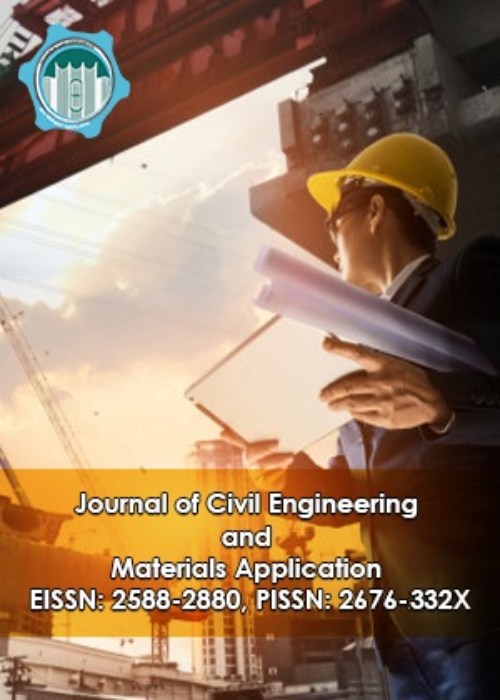فهرست مطالب
Journal of Civil Engineering and Materials Application
Volume:2 Issue: 3, Summer 2018
- تاریخ انتشار: 1397/04/10
- تعداد عناوین: 5
-
Pages 121-131Quality of service is defined as a comparison between customer expectations and service comprehension. Assessment and improvement of bus service quality is so important in order to increase the car ownership rate. In particular, research on the characteristics of service quality is important because of the high impact on customer satisfaction. Previous studies indicate that citizens have six indicators of travel time, convenience, accessibility, price, comfort, information, and safety are more important of other indicators. In this study, modeling of service quality indicators in the bus system of Zanjan city has been investigated. In this way, by these indicators, the most important factors of customer satisfaction were identified. The research method was empirical and the travelers were surveyed and the data extracted from the questionnaires were analyzed using the Smart PLS software. It is worth noting that at the end, a model was developed to determine customer satisfaction with the mentioned variables (quality indicators), which had the highest weights, respectively, safety, relaxation, travel time and convenience. In addition, the satisfaction of this system was 59%.Keywords: Structural models, Satisfaction indicators, urban bus system, PLS
-
Pages 132-137The centrifuge model tests were used to evaluate the geotechnical properties of fiber reinforced soil walls. The reducedscale centrifuge models were built and the clay barrier was prepared using kaoline amended silty soil. The unreinforced soil barrier was found to lose their water-tightness and integrity at lower distortion levels compared to fiber reinforced soil barrier. The silty soil used in the centrifuge models, frequently considered as having negligible creep, did not ultimately found to prevent the development of time-dependent deformations. Thus, the significant time-dependent deformations could be occurred in geotechnical structure of fiber reinforced soil walls wall systems. The long-term behavior of reinforced soil walls structures was investigated under stress levels using centrifuge model.Keywords: Fiber, Centrifuge Model, Silty Soil, Geotechnical Properties
-
Pages 138-145Rocks show a different behavior towards excavation due to their continuity or discontinuity, elastic or inelastic behavior, isotropy or anisotropy and homogenous or heterogeneous nature and the response behavior of tunnels has always been a concern for geotechnical engineers during excavation operations in a variety of stones. Anisotropic rocks have different properties in different directions and also in different locations. In the present study, the effect of foliation orientation on the displacement of tunnels excavated in metamorphic rocks is evaluated. Hence the tunnel excavation is modeled for a metamorphic rock medium in different directions of foliation plane. The results show that the vertical displacement of tunnel crown is seen at a distance of 4 to 6 m from the critical tunnel face in all samples, where more than 60% of deformations occur. It should be noted that 20% of deformations are reported at a distance of 6 to 15 m along the excavation face section.Keywords: Tunnel, Excavation, Metamorphic rock, Foliation orientation
-
Pages 146-158New roundabouts are innovation and revolutionary in roundabout design, with the risk of incidents in these roundabouts far less than traditional common roundabouts. These types of roundabouts control the traffic flow at the entrance and exit of the roundabout, with the guidance of drivers to isolated lines before entering the roundabout and guidance to the spiral lines inside the roundabout as channelized. Another advantage of these roundabouts is the much more balanced division of traffic flows than traditional ones. In Iran, in view of the many problems of capacity, flow and safety of intersections and intersections, this type of roundabout can be very useful in certain conditions. In this research, how these roundabouts are compared and also the comparison of different input capacities based on the origin - destination demand matrix for new roundabouts and common roundabouts of two lanes with the help of Aimsun traffic simulation software have been investigated. For this purpose, the values of traffic indicators of delay time, density, flow, stop time and travel time of computer simulations for new roundabouts and common roundabouts have been investigated and compared. According to the demand matrix of the origin-destination models loaded in the software and comparisons done, the optimal model for the highest capacity and the lowest delay time and travel time is presented. In this simulation, 8 to 16 percent increase in traffic flow and a decrease of 34 to 59 percent for travel time and delay time in the new roundabouts is shown in comparison with the common two-lane roundabouts.Keywords: 2 Lane Roundabout, Density, delay time, Stop Time, Capacity, travel time
-
Pages 159-164Graphene oxide (GO) is a graphite-based product. GO prepare a new distance to interact with cement matrix. GO due to the high specific surface area, high intrinsic mobility and high Young’s modulus leads to a remarkable enhancement in mechanical properties of cementitious material matrix. In the present study, the effect of reduced-graphene oxide (r-GO) on the mechanical properties of Portland cement paste was investigated. Response surface methodology based on central composite design (CCD) was used to predict the interaction effects of curing time (7-21 days) and GO amount (0.02-0.1%) on the compressive strength and flexural strength of the r-GO–cement composite. By optimization of parameters, the compressive strength and flexural strength was increased by 48% and 74% compared with cement without r-GO. The obtained results demonstrated that the r-GO is a promising filler of cement-based composites to enhance the mechanical properties of cementKeywords: Reduced-graphene oxide, cement, CCD, Compressive strength, Flexural Strength


